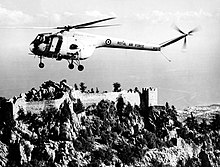Bristol Sycamore
The AFEE had been conducting its own work on the development of rotorcraft designs under the noted helicopter pioneer Raoul Hafner; however, the successful use of Airspeed Horsa and General Aircraft Hamilcar gliders during Operation Overlord had led to helicopter development being recognised as a priority.
[3][1][2] In June 1944, work commenced on the development on a four-seat helicopter intended for both civil and military use; it was out of this programme that the Sycamore would emerge.
On 25 July 1947, the first prototype, VL958, which was powered by a 450-horsepower (340 kW) Pratt & Whitney Wasp Junior (there being no suitable engine in the Bristol range), performed the type's maiden flight.
[1][2] During the flight test programme, Bristol's key development pilots for the Type 171 included Charles "Sox" Hosegood and Col. Robert "Bob" Smith.
In 1951, a Bristol-owned Sycamore Mk.2 was used during a series of deck landing trials performed on board the Royal Navy aircraft carrier HMS Triumph.
[4] An improved model of the helicopter, designated as the Sycamore Mk.3, was rapidly developed; it featured an increased capacity for five occupants, a wider fuselage and a shortened nose.
[1][2] Versions of the Sycamore up to and including the Mk.3A retained the standard two-seat cockpit layout, placing the pilot in the left-hand seat and the co-pilot in the right.
It was isolated in a fireproof enclosure which was fitted with fire detection and extinguishing equipment to meet certification requirements.
[8] Air was drawn through a forward-facing grill to cool the gearbox before passing through the engine cowling and leaving the fuselage.
[8] The Sycamore had a relatively high rotor speed for the era, which was claimed to give a smoother ride and be safer in the event of engine failure.
Numerous Sycamores were transferred to the Far East Air Force to participate in the conflict; however, the type was involved in a number of crashes in the region which had occurred as a result of tail or main rotor blade problems.
Following the end of most combat operations in August 1960, Sycamores remained in the region, including a detachment in Brunei, to support British forces stationed there to deter further aggression by Malayan communist guerrillas.
In December 1971, the last of the RAF's Sycamores were officially retired; this had been due to critical parts having reached the end of their fatigue life.
A single example was used during the construction of the M1 motorway between London and Leeds; the type provided support in various roles, including to perform aerial surveying, communication across various sites, the carriage of both personnel and equipment, and the mitigation of flooding on the project.









